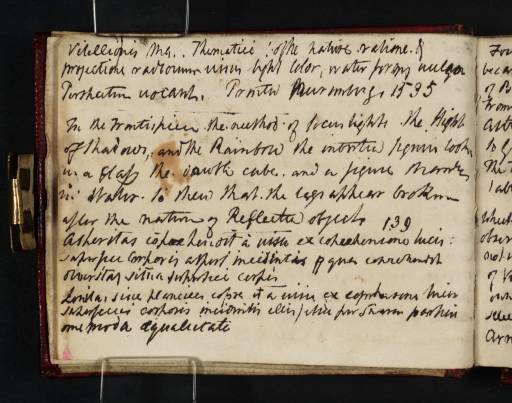The whole page is taken up with the following notes:
Vitellionis. Ma..Thematici : of the nature, ratione, & | projectione radiorum vision light color, water forms vulgar | Perspective vocant. Printed Nuremberg, 1535
In the frontispiece the method of focus lights, the Hight | of Shadows, and the Rainbow the inverted figure looks | in a glass the double cube, and a figure standing | in water, to shew that the legs appear broken | after the nature of Reflected objects 139
Asperitas cõprehendit à uisu ex coprehenione lucis: | superfici corporis asperi incidentis p qua coprehendit | diversitas situu superfici corpis
Lenitas siue plan[...]s copre it a uisu ex coprehensine lucis | superf[...]s corporis incidentis illis /etiã per suaru partiu | omimoda æqualitati
The first section is derived from a Latin edition of Vitellio’s work on perspective,
Vitellionis mathematici doctissimi pe¿¿ ¿¿pt¿¿¿¿: id est de natura, ratione & proiectione radiorum visus, luminum, colorum atque formarum, quam vulgo perspectivam vocant: libri X (Nuremberg 1535).
1 Turner has attempted a partial translation of the title even as he transcribed it (wrongly assuming ‘atque’ means ‘water’ rather than ‘and’).
The subsequent notes describe the complex imagery of the engraved frontispiece, which includes two suns emitting diagonal rays from the upper corners.
The third and fourth paragraphs are apparently random but fairly accurate transcriptions of section headings from the ‘Liber Quartus’, page 115, respectively sections CXXXIX (accounting for the ‘139’ in Turner’s notes) and CXL. The original texts (with ‘u’ standing for both that letter and ‘v’) read: ‘Asperitas cõprehendit à uisu ex cõprehensione lucis superficiei corporis asperi incidentis, p quã cõprehendit diuersitas situu partiu superficiei corpis’; and ‘Lenitas siue planicies cõprehendit à uisu ex coprehensine lucis superficiei lenis corporis incidentis illis etiã per suaru partui omimodã æqualitat¿’ (the first ‘m’ of the penultimate word also being marked with a tilde).
Vitellio, known by a number of variant names including Witelo, was born in Poland early in the thirteenth century, studied in France and Italy and did pioneering work on perspective in the 1270s.
2 Turner probably consulted the copy of the 1535 edition at the British Museum (since transferred to the British Library).

